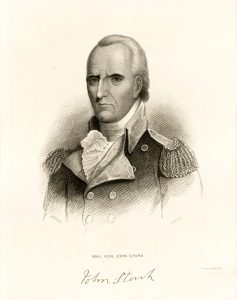Which American generals lived the longest? Which generals died the youngest? Some generals had quite a long life while others died young and in their prime. Here’s what I discovered regarding the longevity (and lack of longevity) of some of the Revolutionary War generals on the American side.
Which American Revolutionary War general lived the longest?
Among Continental Army generals, the longest-lived was Brig. Gen. John Stark of New Hampshire. While brigadier general, he commanded the Northern Department three times, was a judge in the John André court martial, and commanded a brigade at the Battle of Springfield. Stark died at the age of ninety-three.
Brig. Gen. John Nixon of Massachusetts, who fought at the Battle of Harlem Heights and at Saratoga, was the second-oldest, dying at eighty-eight.
Major Generals Arthur St. Clair and Lachlan McIntosh both lived past their eightieth birthdays.

Which American Revolutionary War general died the youngest?
The shortest-lived Continental Army general was Brigadier General Casimir Pulaski. The Polish nobleman, known for forming a cavalry legion, was wounded at the Battle of Savannah and died two days later at age thirty-four.
The second-shortest-living general was Major General Frederick William, Baron de Woedtke, a Seven Years’ War veteran from Prussia whose military career in America lasted a whopping three months before he reportedly died of alcoholism at age thirty-five or thirty-six. De Woedtke was buried in an unmarked grave in what is today the Lake George Battlefield Park.
Richard Montgomery (killed at the Battle of Quebec) and Philippe Charles Tronson du Coudray (drowned) also died young. Both major generals died before their fortieth birthdays.
Which state militia general lived the longest?
South Carolina’s Thomas Sumter was the longest-lived militia general. He is best known for his partisan campaign in South Carolina in 1780 and 1781. His early life is also interesting: Born near Charlottesville, Virginia, he served in the French and Indian War as a Virginia provincial soldier. He accompanied a Cherokee delegation to London at the end of the French and Indian War. He was a U.S. Representative and U.S. Senator in later life.
Sumter, Brigadier General of the 1st Brigade of South Carolina militia, died at age ninety-seven!

John Stark was the second-longest-living militia general. Before he was a general in the Continental Army, he was a brigadier general in the New Hampshire militia and distinguished himself at the Battle of Bennington.
I know of only one general—Continental Army or state militia—who died after Sumter (albeit at a much younger age), and that’s Jeremiah McLene. McLene, a major general in the Pennsylvania militia, died in 1837 while a Member of Congress from Ohio. It appears that McLene—who was born in 1767, was, at age sixteen, the youngest general in the American Revolution.
Which militia general died the youngest?
The shortest-lived militia general appears to be William Caswell, son of North Carolina governor Richard Caswell. William Caswell a brigadier general of the North Carolina militia at the Battle of Brier Creek and the Battle of Rockfish Creek. He died in 1785 at age thirty at his plantation near Kinston.
Joseph Warren of Massachusetts and William Lee Davidson of North Carolina were both militia generals of state militias during the American Revolution. Both died very young. Warren, a Boston doctor and friend of John and Abigail Adams, is one of the most-memorialized generals of the Revolutionary War. He died in battle at Breed’s Hill/Bunker Hill, just three days after being appointed a major general. He had just turned thirty-four. Davidson, the thirty-five-year-old brigadier general pro tempore of the Salisbury District Brigade of North Carolina militia, died in battle in 1781 at Cowan’s Ford.









7 Comments
Very interesting. I would have liked to have known not only how old they were when they died, but what year they died, to get a better idea of where they fit in in the span of American history.
How did McLene become a general when he was only 16??
Thanks, Dan. Concerning McLene, I, too, would like to hear more. I’ve been studying the Continental generals for years, and some militia, but McLene is new to me.
I too would be very interested in knowing how a 16 year old McLene became a general, given the typical norms of succession at the time.
Wife’s father was the first fire chief at Shaw AFB after WWII. Thomas Sumter’s grave site was a mile through the woods over their backyard fence in Stateburg.
In researching McLene, using the library services of the American Revolution Institute of the Society
of the Cincinnati came back blank. No such individual out of 3500 known American/Foreign entries?
No Gen from Penn militias known. It is possible that when the Society was founded in 1783, Jeremiah
being 16 years of age was denied membership? It is also possible that no-such General rank existed
for a youngster in the service? Further, under “rule 1854” which allows for the admission of hereditary representatives of officers who did not join the Society at its founding, but who would have been qualified by rank and length of service. Until 1854, hereditary membership was restricted to descendants of original members and officers who died in battle. The Society maintains a list of other
inductees who have been removed without notice? Contact Rachel Nellis at the library for information
rn*****@so********************.org
Would not Francois Malmedy also be one of the youngest generals? He was born around 1750 from what I can tell and in late 1776 was briefly a militia general in Rhode Island for a short time.
As I recall, William Lee Davidson was only a general for just short of five months before he was killed. It doesn’t compare with Warren’s three days but also a very brief command.